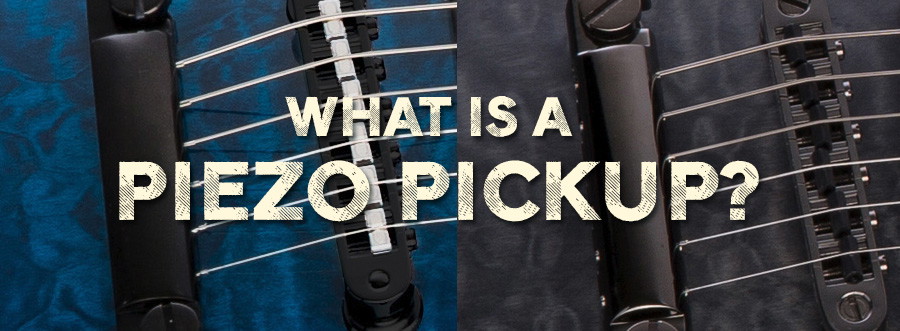What Is a Piezo Pickup?
What Is a Piezo Pickup?


With the release of some of our recent new models like the LTD EC-1000 Piezo and the LTD Signature Series guitar for Ben Burnley of Breaking Benjamin, the BB-600 Baritone, we’ve had a number of people let us know that they’d like to learn more about what a piezo pickup is and how it works. We’re here to help!
First, The Basics
We’re not going to get into very much of the scientific discussion behind piezo (pronounced “pee-YAY-zoh”) pickups, but you will at least want to know a basic idea of what they are and how they’re different from the pickups you already know and love.
Most pickups on electric guitars are magnetic pickups. Whether active (like many from EMG) or passive (like most made by Seymour Duncan), magnetic pickups work on the same principle. The pickup has a magnet or series of magnets that are wrapped in wire coil. Hit a string on the electric guitar and the string vibrates. The field created by the magnet and coil translates the vibration into electrical signals. This is a similar idea in regard to how most microphones work, which is why pickups and mics are both called transducers. They translate acoustic energy into small electrical signals that you can then amplify.
A piezo pickup is very different. First, you don’t even see them on the guitar. Unlike magnetic pickups, which are easily noticed under the strings between the bridge and the neck, piezo pickups in an electric guitar are usually located inside the bridge itself. The reason is simple: piezo pickups work by picking up the actual vibrations of the string and the instrument. That’s why they’ve typically been used as pickups for acoustic instruments, like nylon-string guitars that wouldn’t work with a magnetic pickup.


The EC-1000 Piezo (top) and the BB-600 Baritone (bottom) are two ESP LTD models that include both piezo and magnetic pickups.
How Piezo Pickups Work (TL;DR Version)
Instead of the magnetic field as described above, the piezo pickup actually measures the pressure of the string/instrument vibrations to create the electrical current. They typically use a type of compressed crystal to receive the vibrations (we know it sounds like crazy magical voodoo talk, but trust us, it’s true), and the signal gets translated and preamplified before being sent to the guitar’s output. Piezo-electric pickups, to use their proper name, are actually an older technology than that of magnetic pickups. The more important thing to know as a musician is what to expect from them tone-wise.
How Do They Sound on Electric Guitars?
If none of the information above made you do anything but yawn, that’s okay, because the real thing you came here to learn is what piezo pickups sound like.
It’s said that piezo pickups on an electric guitar produce a more acoustic-like tone, but that’s not exactly accurate. What is being picked up with a piezo is the sound of the strings and the vibrations caused by the resonance of the wood and the hardware… in other words, the actual sound of the guitar. This can be thought of as being more akin to that of an acoustic guitar tone in many ways compared to the tone of magnetic pickups. Piezo pickups are often brighter and less warm than magnetic pickups, allowing for a high degree of string articulation and clarity in your tone. While they may not automatically turn your electric into an acoustic guitar tone-wise, they indeed represent the actual acoustic energy from your electric guitar.
Another thing to be aware of is the dynamic response of piezo pickups. Often, the active circuitry of a piezo pickup system needs to include some kind of compression, because you’ll find that a piezo behaves much differently than a magnetic pickup in regard to how loud or quite it is versus how hard or soft your playing style is. One really nice thing about piezo pickups in regard to overall sound: you won’t have to worry about picking up electrical hum because there are no magnets involved.
For the EC-1000 Piezo, we chose the Fishman Powerbridge, a highly-advanced piezo system that is voiced specifically to add acoustic-type tones to your electric guitar. With the BB-600 Baritone, we went with the Graph Tech ghost Loaded ResoMax saddles, which serve a similar function. In both guitars, we offer dual output jacks that allow you to route the magnetic pickups and the piezo pickups separately (like to two different amps, or two channels of a recording interface, PA, etc.), or in some cases, blend the signals to create a tone that’s fresh and unique.








